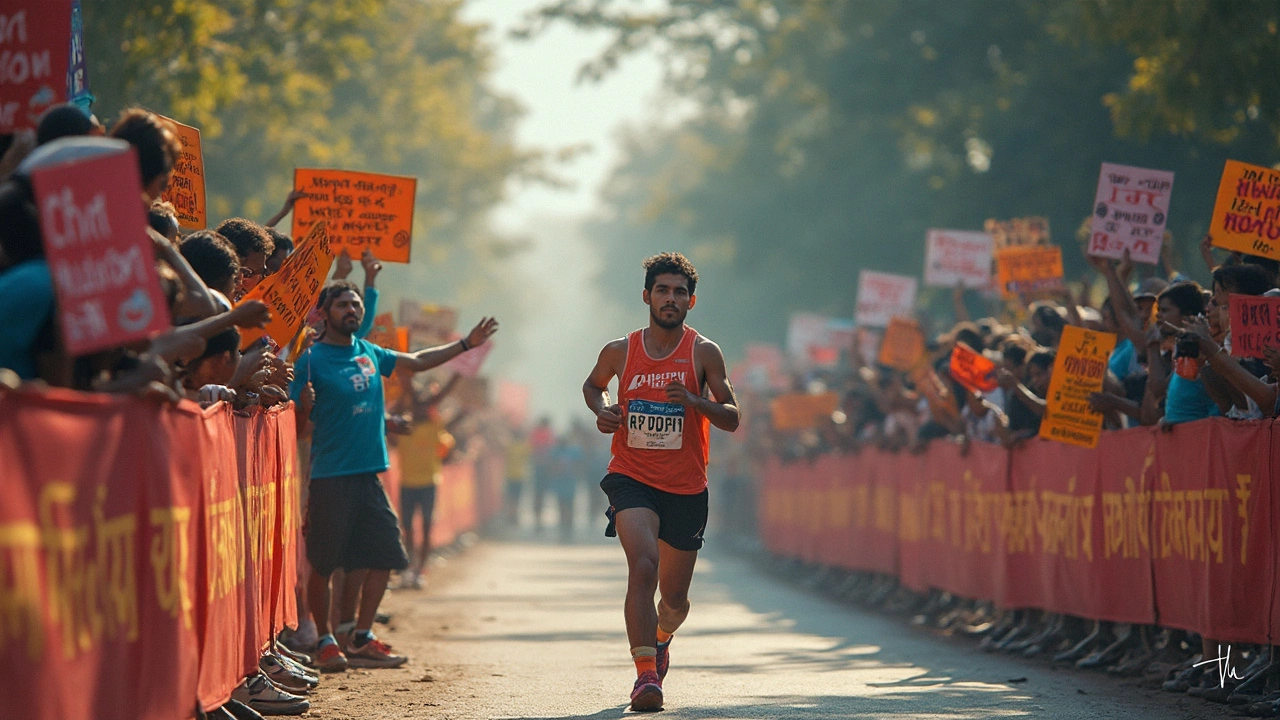Trying to wrap your head around exactly how fast you need to run a marathon in six hours? Let’s cut right to the chase: you’ll need to cover each mile in about 13 minutes and 44 seconds. That’s about a brisk walk or a very easy jog for most people. Sounds manageable, but sticking to that pace for the full 26.2 miles is where the real challenge kicks in.
Lots of runners think you have to run fast to finish a marathon, but that 6-hour target is more about steady consistency. No huge bursts of speed—just holding a gentle rhythm, mile after mile. If you can jog at a pace just faster than your usual walking speed, you’re on the right track. And if you’ve ever joined a parkrun or tried walk-run intervals, this goal is absolutely within reach.
- Doing the Math: What Pace Means for Six Hours
- Training Your Body—and Brain—for Steady Running
- Game-Day Tactics: Keeping Your Pace on Track
- Common Mistakes and How to Dodge Them
- Staying Motivated When the Hours Stretch Out
Doing the Math: What Pace Means for Six Hours
Let’s get super clear about the numbers. The full marathon distance is 26.2 miles (or 42.195 kilometers if you prefer metric). To hit a 6-hour finish, you need to stick to a steady, average pace for every single mile. Grab your phone’s calculator if you want, but here’s the scoop: 360 minutes divided by 26.2 miles comes out to roughly 13 minutes and 44 seconds per mile. That’s your magic number.
If your GPS watch, fitness app, or even a regular stopwatch has a pace feature, go ahead and set it to show that number. If you’re planning in kilometers, you’ll need about 8 minutes and 33 seconds per kilometer. It doesn’t feel fast—it’s a controlled, talk-friendly pace. Honestly, you can even alternate walking and jogging for most of it, as long as you keep things consistent.
Just so you know, most official marathons have a time limit within 6 to 7 hours, so this is the pace where you’ll avoid the “sweeper van” (the vehicle that drives behind the last runners). If you ever lose your pace during the race, don’t panic. Break the rest of the race into chunks—like 5K at a time—and recalculate what you need to average for the rest of the miles. This flexible pace keeps your marathon dream alive even if you need a bathroom stop, refill your water bottle, or walk through a few aid stations.
- To finish in six hours, stick as close as you can to 13:44 per mile or 8:33 per kilometer
- Set your watch, app, or even a sheet of tape on your arm as a reminder
- Don’t sprint at the start—going out too fast makes it ten times harder later
- Practice this marathon pace on your long training runs so it feels natural
The big take-home? When you hear the phrase marathon pace for a 6-hour finish, think of it as a sustainable, comfortable jog-walk tempo that doesn’t burn you out early. Keep it steady and the finish line will feel a whole lot closer.
Training Your Body—and Brain—for Steady Running
Most people focus on just their legs when prepping for a marathon, but your mind has to be just as ready. Six-hour marathons are all about patience and forming good habits. If you can run or walk for around an hour without a meltdown, you can totally train your body for marathon pace at a 6-hour target.
Let’s break it down. Your key to success is getting used to that easy, just-the-right-side-of-walking pace. You need to teach your body to run slow and steady—this is surprisingly tough for a lot of folks, because we naturally tend to start out too quick. Build up with these basics in your training:
- Long Runs: Do a slow, long run or walk/run combo once a week. Start at around 6-8 miles, and add a mile or two each week. Closer to race day, aim for at least one 18-to-20-mile day, even if you mix in walking breaks.
- Easy Mid-Week Runs: Two or three times a week, do easy runs of 3-5 miles at your planned marathon pace. Focus on breathing and running relaxed.
- Mental Reps: Those long stretches out on your own will test your patience. Practice with music, podcasts, or just zoning out. Try visualizing yourself finishing the marathon to stay positive when miles get tough.
- Test Your Gear: Never try socks, shoes, or a shirt for the first time on race day. Use long runs as a dress rehearsal. Trust me, I found out the hard way that new socks can turn into a disaster at mile 14.
Here’s what a basic weekly training schedule could look like:
| Day | Workout |
|---|---|
| Monday | Rest or gentle walk |
| Tuesday | 3-5 miles easy run/walk at marathon pace |
| Wednesday | Rest or cross training (bike, swimming) |
| Thursday | 3-5 miles easy run/walk at marathon pace |
| Friday | Rest |
| Saturday | Long run, gradually building up distance |
| Sunday | Rest or gentle walk/stretch |
Don’t ignore strength training. A couple of 20-minute sessions a week for core, legs, and hips keeps injuries away. I throw in planks and squats during TV commercials. No need to get fancy.
Finally, your brain's going to try every trick to convince you to stop after a couple hours. Break the race into small sections in your head. Think of it as a bunch of easy 5Ks strung together, not one mega-run. Focus on the next mile marker, water station, or playlist track. Each mini-goal is a mini-win that keeps you moving forward.

Game-Day Tactics: Keeping Your Pace on Track
The quickest way to wreck your marathon plans is to start too fast. It feels easy at mile two, but trust me, mile twenty will pay you back—with interest—if you go out hot. For a marathon pace that will get you to that six-hour finish, it’s all about discipline and a little bit of technology.
Use a GPS watch or smartphone app to keep tabs on your mile splits. Many runners swear by setting their device to alert them once they slip above or below that 13:44 per mile pace. If you don’t have fancy gear, jot the split times on your arm or use a cheap pace band (they hand these out at most big races, or you can print one at home).
Don’t ignore the water stations. Dehydration is brutal and slows you down. Even if you're feeling good, grab at least a few sips at each stop—marathon rules usually put stations every two miles or so, but check your race info just to be sure.
One smart trick: Aim for even pacing instead of a fast start and painful finish. Recent race stats from major marathons show that runners who hold their pace steady from start to finish are much more likely to meet their time goal. They don’t lose as much time to cramps or walking in those last tough miles.
| Mile | Elapsed Time |
|---|---|
| 5 | 1:08 |
| 10 | 2:17 |
| 13.1 (halfway) | 3:00 |
| 20 | 4:35 |
| 26.2 (finish) | 6:00 |
On race morning, nerves hit hard, so keep things simple:
- Get in your starting corral early—crowds can eat up precious time.
- Stick to your planned pace, even if other runners fly by you at the start.
- Walk through aid stations if you need to, but keep moving. Short, planned walk breaks are okay and often help conserve energy.
- If you feel tired way before halfway, don’t panic. Slow down a little for a mile, breathe, and ease back into your pace.
Treat your watch as your best friend on marathon day. If you keep glancing at those splits and stay honest about how you feel, you’ll take a ton of guesswork out of your race—and it’ll be a lot less painful when you hit those final six miles.
Common Mistakes and How to Dodge Them
Here’s the blunt truth: the marathon sucks a lot of first-timers into mistakes that can cost hours—or keep you from finishing at all. Most problems come straight from pacing, fueling, or ignoring your body. If you’ve ever watched a race, there’s always a pack of people who look like they regret every decision by mile 18. Let’s make sure that isn’t you.
- Starting too fast: It’s so tempting to burn out of the gate when you feel fresh, but starting at even a minute-per-mile faster than your planned pace early on can leave you walking much later. Studies of marathons like London and Berlin show that runners who hold an even pace are more likely to finish strong. Stick to the target: around 13:44 per mile. That pace is your friend—don’t race it.
- Not fueling early enough: If you wait until you’re tired or hungry to grab that gel or banana, you’re already behind. Most experts recommend fuelling every 30-45 minutes, starting by the 45-minute mark. Bring easy snacks you’ve practiced with, not random stuff from aid stations.
- Ignoring water stations: Hydration can sneak up on you. Missing stations or waiting until you feel parched slows everything down. Drink a few sips at each stop—even if you aren’t thirsty.
- Winging it with new gear: Race day isn’t the time to try new shoes, socks, or shirts. The number of runners who finish with bloody toes or chaffed skin is way higher than you’d guess. Stick to what you used for long runs.
- Overthinking walk breaks: Plenty of 6-hour marathoners walk every few minutes and still finish comfortably. The key is consistency—use walk-run intervals you practiced, not random walk breaks when you’re spent.
Check out how common these mistakes really are. Race data from the Chicago Marathon shows about 30% of runners seeking a 6-hour finish slow down dramatically in the second half:
| Mistake | % of 6-hour runners affected |
|---|---|
| Starting too fast | 42% |
| Poor fueling/hydration | 28% |
| Gear problems (blisters/chafing) | 19% |
| Not following pacing plan | 34% |
If you remember only one thing, let it be this: running a marathon in six hours is all about respecting the rhythm of the marathon pace. Not too fast, not too random, never unprepared. Map out your plan, practice it in training, and you’ll cruise through the finish looking fresher than plenty of runners going for broke.

Staying Motivated When the Hours Stretch Out
Those last few miles of a marathon can really test your mental game, especially when you’re aiming to finish in around six hours. It’s normal to feel your energy dip or your motivation waver as you hit hour four or five. But a steady mindset can make the difference between crossing the finish line strong and losing steam along the way.
One trick is to break the race into small chunks. Think of it like running from one water station to the next, or simply ticking off each mile as its own win. Marathon runners who use this strategy often feel less overwhelmed than those staring at the full 26.2-mile distance the entire time.
Some folks use mantras—short phrases they repeat, like "just keep moving" or "one step at a time." It sounds basic, but studies show that positive self-talk actually boosts endurance and keeps mood up during long runs.
- Create a playlist with songs that pump you up or have a special meaning. Research from Brunel University found that listening to upbeat music during exercise can boost performance by up to 15%.
- Have friends or family at spectating points. Seeing familiar faces—even for a minute—gives your effort a huge lift. My son Tarun always waits at the 20-mile mark with a goofy sign and honestly, that keeps me moving every year.
- Visualize your finish line moment. Picture yourself crossing with arms raised. That mental image gives your brain a finish to focus on when your legs get tired.
- Eat and drink regularly. Low energy can make you grumpy and negative, so stick to a fueling plan to keep spirits high and the body ticking over.
| Strategy | Impact (according to studies) |
|---|---|
| Music playlists | Boosts performance by up to 15% |
| Positive self-talk | Lowers perception of effort, increases persistence |
| Breaking into segments | Reduces mental fatigue and stress |
| On-course support | Improves mood and motivation |
Don’t forget, your marathon pace isn’t just about legs—it’s about attitude. Celebrate every little milestone. When you start to drag, remember why you signed up in the first place. And trust me, finishing after six hours is still a big deal. You put in the training and fought through all the hard bits. That finish line feeling? Totally worth it.





